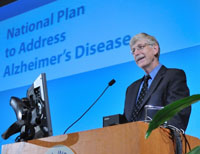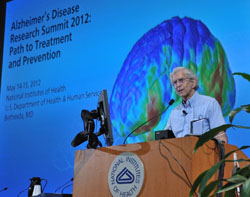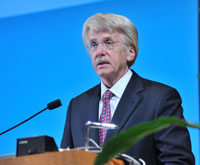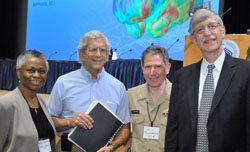Researchers, advocates gather at Summit to accelerate Alzheimer’s research
July 1, 2012
 |
|
Dr. Francis Collins
|
"We are at an exceptional moment scientifically for Alzheimer's,” declared National Institutes of Health (NIH) Director Dr. Francis Collins before more than 500 researchers and advocates gathered on the NIH campus May 14-15 for the “Alzheimer’s Disease Research Summit: Path to Treatment and Prevention.” Significant progress has been made, but much more needs to be done, Collins told the group. “This is not about just celebrating where we've come from, but rolling up our sleeves to see where we can go," he said.
Collins’ remarks came as Health and Human Services Secretary Kathleen Sebelius visited the Summit to unveil a new National Plan to Address Alzheimer’s Disease. The plan, mandated by the January 2011 National Alzheimer’s Project Act, sets forth five goals for Alzheimer’s research, care, and services; the first goal is development of effective prevention and treatment approaches for Alzheimer’s disease and related dementias by 2025.
 |
|
Dr. Kathleen Sebelius
|
In addition to research, Secretary Sebelius outlined other major goals of the plan and announced a number of actions being taken now, including training for physicians assessing patients for memory loss and a new public awareness campaign about federal and other information resources available about the disease and caregiver support.
The awareness campaign features establishment of a new federal portal website—www.alzheimers.gov—and easier access to information, including that on disease, diagnosis, research, and clinical trials found at the NIA Alzheimer’s Disease Education and Referral (ADEAR) Center.
The Secretary stressed the urgency of ramping up research and other national efforts on Alzheimer’s disease. “A lot more needs to be done and it needs to be done right now, because people with Alzheimer's disease and their loved ones and caregivers need help right now," she said.
 |
|
Dr. Richard Hodes
|
The Summit, hosted by the NIH and the Department of Health and Human Services, with private-sector support through the Foundation for the NIH, will inform the new national plan’s research goal. It brought together representatives from academia, industry, and the advocate community. “These are the very groups that need to work together if we are going to most effectively approach the problem that Alzheimer's disease presents,” said NIA Director Dr. Richard Hodes.
“The overall purpose of the Summit was to develop new ways of thinking about treatment and prevention for Alzheimer’s,” said Dr. Neil Buckholtz, chief of the Dementias of Aging Branch in the NIA Division of Neuroscience, who led the organization of the event. “We expect recommendations that will provide us with better approaches toward finding treatments, as well as indicating the kind of infrastructure that we need to modify or develop in order to get us to better therapeutics in the future.”
 |
|
Dr. Ron Peterson
|
Fifty-seven presenters and panelists were asked to address six topics critical for identifying effective therapies for treatment and prevention:
- Interdisciplinary approach to discovering and validating the next generation of therapeutic targets
- Challenges in preclinical therapy development
- Whom to treat, when to treat, and what outcomes to measure
- Drug repurposing and combination therapy
- Nonpharmacological interventions
- New models of public-private partnerships
At the end of the Summit, a writing committee comprised of a subgroup of presenters and panelists formulated a series of research recommendations and highlighted the major overarching themes:
-
Recognize the heterogeneity and the multifactorial nature of the disease. Drs. Bernard, Hodes, Buckholtz, and Collins
Drs. Bernard, Hodes, Buckholtz, and Collins - Employ new research paradigms such as systems biology and network pharmacology.
- Enable rapid and extensive sharing of data, disease models, and biological specimens.
- Build new multidisciplinary translational teams and create virtual and real spaces where teams can operate.
- Develop strategies to overcome intellectual property barriers to Alzheimer’s disease drug development.
- Develop new public–private partnerships.
- Establish a national Institutional Review Board for Alzheimer’s disease clinical research.
The Summit event also highlighted an announcement by Dr. Collins of two new major grant awards for clinical trials. The trials are being supported as part of an additional $50 million in fiscal 2012 funding directed from within NIH toward Alzheimer’s research.
One trial will test whether an insulin nasal spray can improve memory, cognition, and daily functioning among people with mild cognitive impairment and mild to moderate Alzheimer’s. Dr. Suzanne Craft, of the University of Washington and Veterans Affairs Puget Sound, and her team will conduct the year-long treatment trial at multiple sites across the U.S. At the end of the treatment period, researchers will compare cognition, memory, and functional performance between the treated and control groups.
A 5-year prevention trial will focus on people who are cognitively normal but at extremely high risk of developing early-onset Alzheimer’s disease, a rare, genetic form of the disease that can cause people in their mid-40s to develop symptoms.
The trial, an international collaboration led by Drs. Eric Reiman and Pierre Tariot at the Banner Alzheimer’s Institute in Phoenix, will test a promising drug intervention in symptom-free adults with a family history of early-onset Alzheimer’s. Participants will include some 300 members of a large, unique Colombian family who share a genetic mutation causing early-onset Alzheimer’s, as well as a smaller number of U.S. volunteers. Brain scans, fluid biomarkers and cognitive testing will be used to track changes in brain structure and function and cognitive performance.
Page last updated: December 27, 2012

